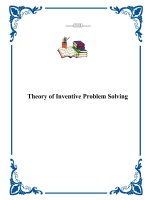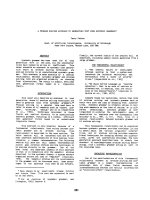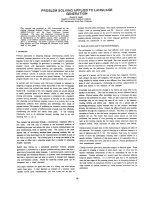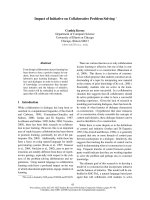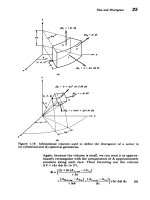Problem Solving .Pdf
Bạn đang xem bản rút gọn của tài liệu. Xem và tải ngay bản đầy đủ của tài liệu tại đây (8.63 MB, 54 trang )
PROBLEM SOLVING
ANH NGUYEN
GOALS
qHiểuđượctầmquantrọngcủagiảiquyếtvấnđề
qXácđịnhvàhiểucácbướccầnthiếtđểcómộtquitrìnhgiảiquyếtvấnđềthành
cơngtạibộphậncủabạn
üVănhóadịchvụ
üXácđịnhvấnđề
üPhụchồidịchvụ
üTheodõi,đolườngvàduytrì
Hiểucácbước ếptheovàcáccơngcụhiệncóđểbắtđầupháttriểnvănhóaGiải
quyếtvấnđề
By the end of our call today, you will
Understand the importance of Problem Resolutio
. Be able to define and understand the steps required for a successful Problem Proces
. And have a clear idea of the next steps and resources that are available to you to drive a culture of Resolution in your hotel
n
.
s
n
:
ti
There will be an opportunity for questions and answers at the end and the slides with more details on the resource will be sent to you after the sessio
TẦM QUAN TRỌNG CỦA
GIẢI QUYẾT VẤN ĐỀ
We all work hard to create Guests Love. However, we also know that things do go wrong
sometimes and guest complaints will happen. This in itself is not a big issue if the
complaints are handled properly. Let’s have a look at the numbers.
Reviews tells us that 1 in 4 of our guests experience problems at our hotels and half of
them don’t tell us about the problem. Of the half that do tell us, 80% are unhappy with the
way we resolve the problems – that’s 10% of all our guests.
And remember, this excludes the other half of the guests who had problems but didn’t tell
us about it – that’s 60% of guests who leave our hotels unhappy in total!
But problems actually give us the opportunity to resolve them well so that they become
more satisfied and loyal than guests without problems.
Instead, the key to driving Overall Experience is how well we resolve the problems that
occur. From Reviews, we found that a guest who had a problem that was not resolved
well gives us an average Overall Experience low score. In contrast, someone who had the
problem resolved well scores us an average score or maybe higher. That is better for sure!
CÁC YẾU TỐ CỦA
GIẢI QUYẾT VẤN ĐỀ
Problem Resolution is made up of 4 components:
The foundation to good Problem Resolution is a GM led service culture in which colleagues feel
empowered and trusted to deal with guest problems. As hotel leaders, you contribute greatly to
building this culture by leading by example and identifying to the team that you are focusing on
problem resolution.
Problem identification: This involves inspiring the team to actively seeking guest feedback while
the guest is still on property and maximizing existing opportunities for our guests to tell us
what’s wrong. Because only if the guest tells us about the problem can we make it better and
currently half of our guests who have a problem do not tell us.
Service recovery:
This addresses how we make it right for the guest when they tell us something has gone wrong
and involves empowering the team to own and resolve guest’s issues to the guest’s satisfaction.
Finally, we need to track, measure and sustain. We need to track problems and resolution /
follow up; analyze our findings to identify and fix recurring issues; measure our progress against
our goal; and reward the right behaviors.
Let’s look at each of the components in more detail.
WHAT IS SERVICE CULTURE?
EMPOWERMENT
Is every colleague in your hotel comfortable asking guests about their stay and genuinely
interested to find out and resolve guest issues to the guest’s satisfaction?
In a hotel where there is a real culture of empowerment, colleagues at all levels genuinely
want to know if a guest had issues so that they can fix the issue for the guest and they are
constantly heard asking guests about their stay.
How often do we see or experience someone asking how your stay was, only to respond
with an awkward “I’m sorry” and a quick change of subject if you mentioned any problems?
Many colleagues respond this way because they do not know what the appropriate
response is or do not wish to take responsibility for another department’s errors. They likely
do not know what they can do to fix the issue, who to escalate the issue to, and most of all
fear that they will be scolded by their superiors for taking time away from their day jobs to
solve the issue or for compensating guests.
In other words, they are not feeling truly empowered to handle guest complaints on the spot.
Độingũcủabạncóthậtsựthoảimáikhihỏi
“Ngàicóhàilịngvớikìnghỉcủamìnhkhơng?”
ti
ûSợnghecâutrảlời
ûKhơngmuốnchịutráchnhiệmcholỗicủabộphậnkhác
ûKhơngbiếtlàmthếnàođểkhắcphụcvấnđề
ûKhơngbiếtbáocáosựviệctớiai
ûKhơng nrằngbanquảnlísẽủnghộphươngáncủamình
Khơngđượctraoquyền
Bước 4: Loại bỏ rào cản
• Dễ tiếp cận
• Quyền
• Khơng có hình phạt
Qui trình hạ
giá/ đền bù
Staffing levels
Rào cản giải quyết vấn đề
Tiếp cận ban
quản lí
• Tiếp cận ban quản lí
• Khả năng báo cáo
• Sự tin tưởng
Quản lí thời
gian
• Khả năng dành thời gian
để giải quyết vấn đề ngay
trong ca làm việc
• Lên kế hoạch trước đối với
giờ cao điểm
Chương trình
ghi nhận
• Ghi nhận đối với
những nhân viên
mang lại trải
nghiệm tốt cho
khách hàng
• Ban quản lí dành
thời gian tiếp xúc
với khách hàng
13
Hãy hỏi khách các câu hỏi cụ thể về kì nghỉ của họ
NÊN
ü “Đêm qua ngài có ngủ ngon khơng?”
ü “Liệu chúng tơi có thể làm gì để kì nghỉ
của ngài thoải mái hơn không?”
ü “Tốc độ đường truyền Internet theo ngài
như thế nào?”
ü “”Bữa sáng nay của ngài thế nào?”
ü “Chất lượng dịch vụ trong kì nghỉ của
ngài như thế nào?”
ü Các câu hỏi cụ thể đối với các vấn đề tái
diễn hoặc các mục tiêu chính của chúng
ta
KHƠNG NÊN
û “Kì nghỉ của ngài thế nào?”
û “Mọi thứ trong phịng có ổn
khơng?”
Và hãy đảm bảo
rằng chúng ta có
qui trình cho các
bước tiếp theo
18
Định nghĩa Phục hồi dịch vụ
Phục hồi dịch vụ - cơ hội
để sửa chữa và xây dựng
lòng trung thành khi có
vấn đề trong kỳ nghỉ của
khách
21
The Customer Complaint Iceberg_ Tảng băng phàn nàn
22
Tại sao cần?
9
• Vì đối thủ cạnh tranh, _____%
khách hàng sẽ bỏ chúng ta/
14
• Vì sự khơng hài lịng với sản phẩm, ____%
khách hàng sẽ bỏ chúng ta /
67
• Vì chất lượng dịch vụ kém và thái độ thờ ơ của nhân viên,____%
khách hàng sẽ bỏ chúng ta
24
I LEAD
Xác định vấn đề của khách hàng
Lắng nghe
Thấu cảm
Xin lỗi
Thực hiện giải pháp
25
I – Identify_ Xác định
Manh mối không lời
Nhận xét/ Phàn nàn gián tiếp
ü Thở dài/ Đảo mắt liên tục
ü Chế nhạo, mỉa mai
ü Tránh giao tiếp bằng mắt, nói nhỏ hơn hoặc khơng rõ ràng
ü Bối rối
ü Nói nhát gừng, đứt đoạn
ü Ngạc nhiên
ü Lưỡng lự, chần chừ
ích
h
k
ến ủa họ
y
u
h
c
k
ề
ể
đ
đ
o
ấn
à
v
n
ẻ
s
ch
a
á
i
c
h
c
m
g
à
n
L
à
h
h
?
c
a
á
t
h
g
k
n
ú
h
c
vớ i
26
L – Listening_ Lắng nghe
Nguyên tắc lắng nghe cơ bản
Lắng nghe dự đoán thái độ
Lắng nghe dự đoán mức độ ảnh hưởng
27
L – Listening_ Lắng nghe
Tránh ngắt lời, hãy để khách thể hiện cảm xúc của mình
Nguyên tắc lắng nghe cơ bản
Hãy gật đầu và thể hiện bạn đang lắng nghe
Hãy dùng các câu hỏi để tìm kiếm thêm thơng tin
Kiểm sốt cuộc nói chuyện
28
L – Listening_ Lắng nghe
Practice 1
Nguyên tắc lắng nghe cơ bản
29
L – Listening_ Lắng nghe
Practice 2
Nguyên tắc lắng nghe cơ bản
30
